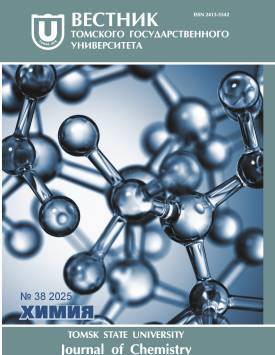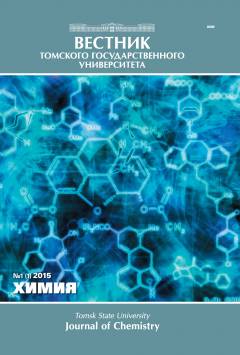Application of a cellulose-containing composite material for tungsten extraction from acidic solutions
Currently, high-purity fluorine-containing gases are used in the production of high-purity semiconductor materials in the Russian Federation. The total content of impurities in them should not exceed 10 ppm with a main substance content of 99.999%. In this regard, there is a need to determine impurities in fluorine-containing gases, in particular, in tungsten hexafluoride, with a low detection limit. During the study of the quantitative composition of the gas, there is a need to purify waste water from tungsten, the maximum permissible concentration of which in water objects is 0,05 mg/l. A promising direction is the development of sorbents based on cellulose, the sorption properties of which are generally recognized and studied in many works. It is known that the integration of cellulose into various substrates significantly increases their sorption capacity. One of the main methods of using such composite materials is considered to be immersion in a solution containing a valuable component, the advantages are high sorption capacity in comparison with other natural sorbents, lower cost and environmental friendliness in comparison with materials with higher sorption capacity. In this paper, a method for producing a composite material in the form of a cellulose-containing coating on carbon fiber is proposed, including the stages of washing and drying the anode and cathode, electrochemical deposition of cellulose-containing coatings on the anode with a stepwise increase in voltage, washing the anode deposits and drying to a constant weight. The coating thickness after three deposition cycles was 19,1 - 21,2 pm. Surface studies using scanning electron microscopy showed that the material was macroporous with a maximum pore distribution in the range of 0,5 - 2,0 pm. The tungsten content in solutions was determined using a mass spectrometer with inductively coupled plasma. The sorption capacity of the composite material at pH 2 and a solution temperature of 20 °C was 15,1 - 16,7 mg/g. It was assumed that the sorption of tungsten from acidic solutions occurred primarily by the mechanism of physical sorption and, to a lesser extent, of anion exchange. Contribution of the authors: the authors contributed equally to this article. The authors declare no conflicts of interests.
Keywords
cellulose,
carbon fiber,
composite material,
tungsten,
sorption isothermAuthors
| Chubenko Iana B. | Seversk Technological Institute - branch of the National Research Nuclear University "MEPhi" | yana-sti@bk.ru |
| Guzeev Vitaliy V. | Seversk Technological Institute - branch of the National Research Nuclear University "MEPhi" | vvguzeev@mephi.ru |
| Molokov Petr B. | Seversk Technological Institute - branch of the National Research Nuclear University "MEPhi" | pbmolokov@mephi.ru |
| Muslimova Alexandra V. | Seversk Technological Institute - branch of the National Research Nuclear University "MEPhi" | avmuslimova@mephi.ru |
Всего: 4
References
Пат. 2206499 C1 Российская Федерация, МПК B01D 53/02, B01D 53/04, B01J 20/18. Способ очистки газообразного трифторида азота / Игумнов С.М., Харитонов В.П.; заявитель и патентообладатель Игумнов С.М. № 2002105042/12; заявл. 26.02.2002; опубл. 20.06.2003, бюл. № 4.
Пат. 2744357 C1 Российская Федерация, МПК C01B 21/083, F25J 3/08, C07C 17/38. Способ очистки трифторида азота от примеси тетрафторида углерода / Чолач А.Р., Яковин Д.В.; заявитель и патентообладатель ФГБУН "Федеральный исследовательский центр "Институт катализа им. Г.К, Борескова Сибирского отделения Российской академии наук" № 2020123306; заявл. 14.07.2020; опубл. 05.03.2021, бюл. № 7.
Королев Ю.М. Фторидный передел в технологии вольфрама. М.: Спутник +, 2018. 152 с.
Красовский А.И. Фторидный процесс получения вольфрама. М.: Наука, 1981. 260 с.
Trubyanov M.M. An improved back-flush-to-vent gas chromatographic method for determi nation of trace permanent gases and carbon dioxide in ultra-high purity ammonia // Journal of Chromatography A. 2016. Vol. 1447. P. 129-134.
СанПиН 1.2.3685-21. Гигиенические нормативы и требования к обеспечению безопасно сти и (или) безвредности для человека факторов среды обитания. М., 2021. 988 с. URL: https://ds278-krasnoyarsk-r04.gosweb.gosuslugi.ru/netcat_files/19/8/SP123685_21_0.pdf.
Аuthor's Certificate А. S. 922088 A1 СССР, МПК C02F3/28, C02F3/28, C02F101/20, C02F103/16. Способ очистки сточных вод от ионов вольфрама и молибдена / Илялетдинов А.Н., Зайнуллин Х.Н., Смирнова Г.Ф., Галиакбаров М.Ф.; заявитель и патентообладатель Уфимский нефтяной институт № 2864014/29-26; заявл. 03.01.1980; опубл. 23.04.1982, бюл. № 15.
Воропанова Л.А., Гетоева Е.Ю. Влияние рН среды на поглощение и кинетику сорбции вольфрама (VI) из водных растворов // Трудяг СКГМИ (ГТУ). 2000. № 7. С. 134-141.
Гетоева Е.Ю. Интенсификация процессов сорбционного извлечения анионов хрома (VI), молибдена (VI) и вольфрама (VI) из водных растворов: дис. канд. техн. наук. Владикавказ, 2015. 178 с.
Пат.RU 2230129 C1 Российская Федерация, МПК С22В34/36, 3/24. Способ сорбции вольфрама (VI) / Воропанова Л.А., Гагиева Ф.А., Гагиева З.А., Пастухов А.В.; заявитель и патентообладатель Воропанова Л.А. № 2002125955/02; заявл. 01.10.2002; опубл. 10.06.2004, бюл. № 6.
Пат.RU 2633677 С1 Российская Федерация, МПК С22В34/36, С01G41/00, C22B3/12, C22B3/24. Способ переработки растворов после карбонатной переработки вольфрамовых руд / Дьяченко А.Н., Крайденко Р.И., Передерин Ю.В., Кантаев А.С.; заявитель и патентообладатель АО "Закаменск" № 2016140095; заявл. 11.10.2016; опубл. 16.10.2017, бюл. № 29.
Пат.RU 2176677 C2 Российская Федерация, МПК С22В34/36, 3/24. Способ извлечения вольфрама (VI) из водного раствора / Воропанова Л.А.; заявитель и патентообладатель Воропанова Л.А. № 96116265/02; заявл. 06.10.1998; опубл. 10.12.2001, бюл. № 3.
Батуева Т.Д. Мезопористые кремнеземные материалы и их сорбционная способность по отношению к ионам вольфрама (VI) и молибдена (VI) // Неорганические материалы. 2019. Т. 55, № 11. С. 1213-1218.
Роговин З.А. Химия целлюлозы и ее спутников. М.: Госхимиздат, 1953. 679 с.
Maurer S.A. Cellulase Adsorption and Reactivity on a Cellulose Surface from Flow Ellip-sometry // Ind. Eng. Chem. Res. 2012. Vol. 51 (35). P. 11389-11400.
Аутлов С.А. Микрокристаллическая целлюлоза: структура, свойства и области применения // Химия растительного сырья. 2013. № 3. С. 33-41.
Никифорова Т.Е. Сольватационно-координационный механизм сорбции ионов тяжелых металлов целлюлозосодержашцм сорбентов из водных сред // Химия растительного сырья. 2010. № 4. С. 23-30.
Azzouz A. Review of nanomaterials as sorbents in solid-phase extraction for environmental samples // Trends in Analytical Chemistry. 2018. Vol. 108. P. 347-369.
Земскова Л.А. Модифицированные сорбционно-активные углеродные волокнистые материалы // Российский химический журнал. 2004. Т. 158, № 5. С. 53-57.
Джиордано К. Сорбента: и их клиническое применение. Киев: Вища школа, 1989. 400 с.
Игумнов М.С. Электрохимические методу: извлечения редких, благородных и цветных металлов из вторичного сырья // Российский химический журнал. 1988. Т. 42, № 6. С. 135-142.
Симамура С. Углеродные волокна. М.: Мир, 1987. 304 с.
Ермоленко И.Н. Элементосодержащие угольные волокнистые материалы. Минск: Наука и техника, 1982. 272 с.
Trevino M.J. Nanosorbents as Materials for Extraction Processes of Environmental Contaminants and Others // Molecules. 2022. Vol. 27. P. 2-19.

